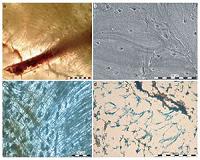 |
Uppsala, Sweden (SPX) May 06, 2011 Scars on the jaw of a 120 million year old marine reptile suggest that life might not have been easy in the ancient polar oceans. The healed bite wounds were probably made by a member of the same species. Such injuries give important clues about the social behaviour of extinct sea creatures from the time of dinosaurs. The find is described in a forthcoming issue of Acta Palaeontologica Polonica. Found in the remote desert near the town of Marree in northern South Australia, the fossilised skeleton belonged to an ichthyosaur, a dolphin-like marine reptile that lived during the 'Age of Dinosaurs'. Ichthyosaurs were fast swimming predators that fed on fish and squid-like animals. Adults would have been around six metres in length and had long-snouted heads with over 100 pointed, crocodile-like teeth. When the ichthyosaur was alive, the Australian continent was still joined to Antarctica and would have been much further south than it is today close to the southern polar circle. What is now arid grassland was then the bottom of a vast inland sea that experienced freezing water temperatures and even seasonal icebergs. The surprising discovery of well preserved bite marks on the bones of the ichthyosaur's lower jaw were made during painstaking cleaning and reassembly of its skeleton in the laboratory. Evidence of advanced healing indicates that the animal survived the attack and lived on for some time afterwards. "Pathological traces on ancient fossilised bones and teeth give unique insights into the lives and social behaviours of extinct animals" says Benjamin Kear, one of the authors of the study and an Assistant Professor with the Palaeobiology Programme at Uppsala University. "Such finds have also rarely been reported in ichthyosaurs before". The size and spacing of the tooth marks do not match any potential predators or prey. Rather, they are most consistent with another adult ichthyosaur, suggesting that the wounds were inflicted during combat over food, mates or territory. Facial biting is a common social interaction observed in animals today and is often directed towards restraining the opponents jaws. Zammit, M. and Kear, B.P. 201X. Healed bite marks on a Cretaceous ichthyosaur. Acta Palaeontologica Polonica 5X (X): xxx-xxx. doi:10.4202/app.2010.0117
Share This Article With Planet Earth
Related Links Explore The Early Earth at TerraDaily.com
 Endogenous Proteins Found In Ancient Giant Marine Lizard
Endogenous Proteins Found In Ancient Giant Marine LizardLund, Sweden (SPX) May 04, 2011 Fossil - just stone? No, a research team in Lund, Sweden, has discovered primary biological matter in a fossil of an extinct varanoid lizard (a mosasaur) that inhabited marine environments during Late Cretaceous times. Using state-of-the-art technology, the scientists have been able to link proteinaceous molecules to bone matrix fibres isolated from a 70-million-year-old fossil; i.e., they ... read more |
|
| The content herein, unless otherwise known to be public domain, are Copyright 1995-2010 - SpaceDaily. AFP and UPI Wire Stories are copyright Agence France-Presse and United Press International. ESA Portal Reports are copyright European Space Agency. All NASA sourced material is public domain. Additional copyrights may apply in whole or part to other bona fide parties. Advertising does not imply endorsement,agreement or approval of any opinions, statements or information provided by SpaceDaily on any Web page published or hosted by SpaceDaily. Privacy Statement |